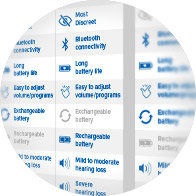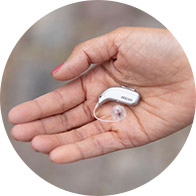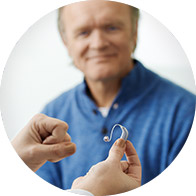
Guide to selecting the best hearing aid for you
Choosing a hearing aid and having it fitted to your hearing needs can have a big impact on your quality of life. Therefore, we also recommend that you get advice from one of our professional hearing care experts when choosing the best hearing aid for you.
Step 1. Compare the available hearing aid styles
Start out by using the overview below to understand the differences between each type of hearing aid.
The overview will prepare you for Step 2 of the guide, where we will explain the 6 important factors that you should consider when choosing hearing aids.
| Most discreet | ✔ | ✔ | ✗ | ✗ | ✔ | ✔ | ✗ | ✗ |
| Bluetooth® connectivity |
✗ | ✗ | ✔ | ✔ | ✔ | ✔ | ✔ | ✔ |
| Long battery life | ✗ | ✗ | ✗ | ✔ | ✔ | ✔ | ✔ | ✔ |
| Easy to adjust volume and programs | ✗ | ✗ | ✗ | ✔ | ✔ | ✔ | ✔ | ✔ |
| Exchangeable battery | ✔ | ✔ | ✔ | ✔ | ✔ | ✗ | ✔ | ✔ |
| Rechargeable battery |
✗ | ✗ | ✗ | ✗ | ✗ | ✔ | ✗ | ✗ |
| Mild to moderate hearing loss | ✔ | ✔ | ✔ | ✔ | ✔ | ✔ | ✔ | ✔ |
| Severe hearing loss | ✗ | ✗ | ✗ | ✔ | ✔ | ✔ | ✔ | ✔ |
| Profound hearing loss | ✗ | ✗ | ✗ | ✗ | ✗ | ✗ | ✔ | ✔ |
The above hearing aids represent different types of Oticon models.
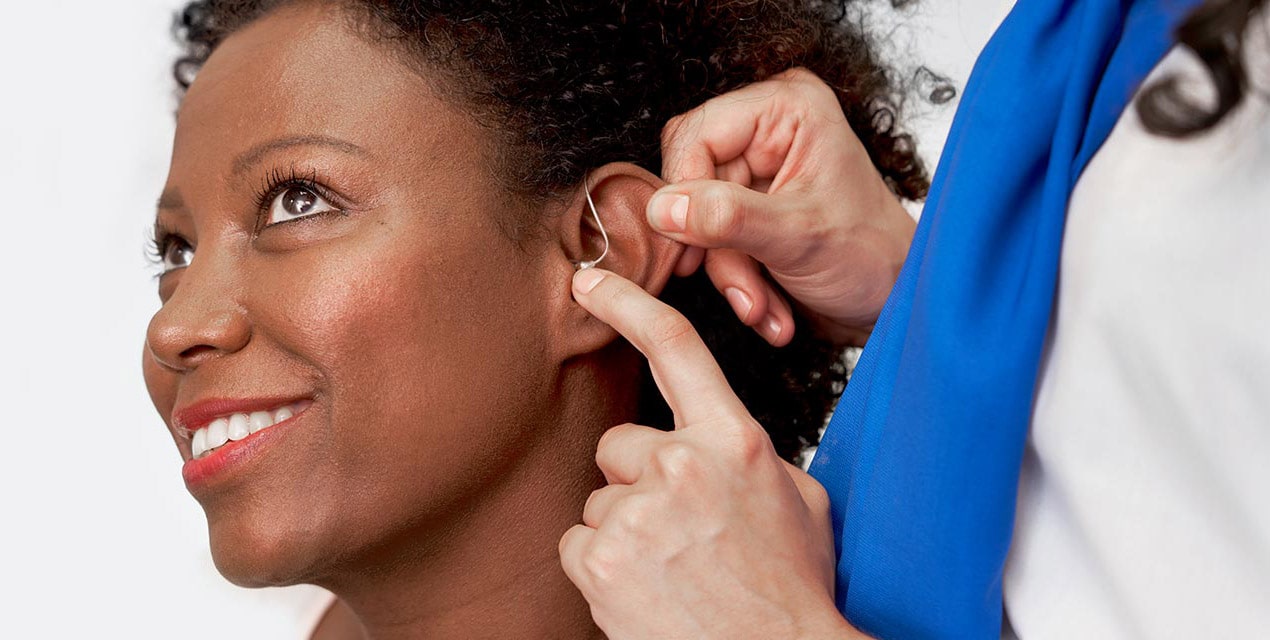
Book an appointment for your risk-free 30-day hearing aid trial
Try our new cutting-edge hearing aids with the latest technology.
Fill in your contact information, and we will call you to set up an appointment in one of our centers near you.
Step 2. Consider these six factors when choosing a hearing aid
In this step we will describe 6 different factors that you should consider when choosing the best hearing aid for you.
- Your level of hearing loss
- Hearing aid technology
- Comfort
- Price and quality
- Style
- Lifestyle
Factor 1 - Your level of hearing loss
The severity of your hearing loss has an impact on the types of hearing aids that you can choose from. Therefore, getting your hearing assessed and knowing your level of hearing loss will help you to understand what hearing aid types will be best suited to accommodate your needs.
The 5 degrees of hearing loss are:
- Normal hearing (≤25 dB)
- Mild hearing loss (26-40 dB): Quiet and soft conversations - or situations with only some background noise - may become difficult to understand.
- Moderate hearing loss (41-60 dB): Higher volume levels are required for radio and TV, and conversations accompanied by background noise become difficult to understand.
- Severe hearing loss (61-80 dB): Difficulties with speech and group conversations in both quiet and noisy environments. Comprehension is impossible without amplification.
- Profound hearing loss (greater than ≥81 dB): Difficult or impossible to hear and understand amplified devices or speech in any environment.
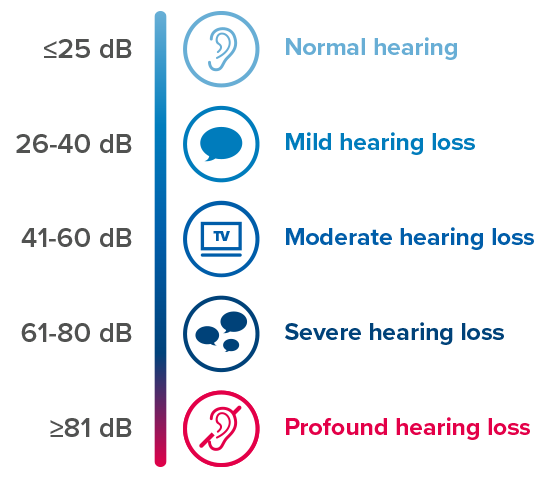
Mild to moderate hearing loss:
Choose any type of hearing aid (or all the types represented in Step 1).
Severe hearing loss:
Choose between selected types of hearing aids, such as “miniRITE”, or “Plus Power Behind-The-Ear”.
Profound hearing loss:
In terms of hearing aids, choosing the “Plus Power Behind-The-Ear” hearing aid will probably be the right solution for you. In cases of very profound hearing loss, ‘cochlear implants’ might be an option for those who are interested in a more permanent solution (as surgery is required.)¹
Conclusion:
Do you know the level of your hearing loss?
In order to know your level of hearing loss, we advise you to book a complimentary hearing assessment in one of our hearing centers near you. The consultation includes: discussing your medical history and hearing needs (case history), receiving a comprehensive diagnostic evaluation of your hearing, reviewing your results, and discussing your hearing needs and potential solutions with a hearing care expert.
Today's advanced technology offers a more natural sound experience by providing an open, 360-degree sound experience and higher sound quality with less effort. Tinnitus support settings are also new features which benefit users. Hearing aids today can also reduce feedback (or the “whistling sound” that some hearing aid users can experience). It is also possible to connect modern hearing aids to your smart devices and TV, so that you can hear your audio directly through your hearing aids.

360-degree sound experience
Some modern hearing aids (such as the Oticon Opn S™) have the technology to provide you with a “360-degree sound experience” so that you can focus mostly on the sounds directly around you or in front of you. These advancements provide higher sound clarity with less effort and allow you to understand speech better in all settings.
Learn more about what the Oticon technology can do for you:
Oticon BrainHearing™
This technology is based on the fact that we hear through our brains, and our ears are merely responsible for picking up the soundwaves. BrainHearing™ by Oticon supports the brain’s natural process of making sense of sound by allowing the brain to hear in the most natural way possible, thereby reducing fatigue. BrainHearing™ technology provides the following benefits: open access to all speakers, background noise reduction, speech clarity, sound localization for improving focus, and personalized programming settings.

Feedback reduction
Feedback (which is often experienced as a whistling sound) can occur when acoustic signals escape the ear canal and hit the microphone on the hearing aid, producing a whistling sound. However, feedback in modern hearing aids is much less common due to new technology supporting the prevention of the feedback sound.

Tinnitus support
Many of those with hearing loss also experience symptoms of tinnitus. Recent technology allows users to listen to relief sounds through their hearing aids which help to sooth and decrease the annoyance of tinnitus.
Oticon offers a specific program called Tinnitus SoundSupport™. You can also choose to simply stream your favorite sounds from your smartphone into your hearing aids as a way to relieve tinnitus symptoms.
Learn to get relief from tinnitus:

Device connectivity
Another popular feature is connecting your hearing aids to mobile phones or tablets so that phone conversations, music, or video calls can be heard directly through the hearing aids. This allows you to experience clear, high quality sound. It is also possible to connect your hearing aids to your television. You can then customize the volume of the program so that it can be as loud (or as quiet) as you want; meanwhile, your family members can enjoy the TV at their chosen volume.

Rechargeable batteries
Some modern hearing aids can be powered by rechargeable batteries. 3 hours of charge will provide a full day of power (including the power needed for wireless connections and streaming).
Rechargeable batteries are economical in the long-term and typically only require replacement every 3-5 years.
Learn more about hearing aids with rechargeable batteries:
Conclusion:
Would you like to try a modern hearing aid?
By booking an appointment in one of our centers, you can experience some of the latest technologies.
Try a hearing aid risk-free for 30 days
Factor 3 - Comfort
When you are choosing hearing aids, it’s important to consider how comfortable they will be for you to wear.
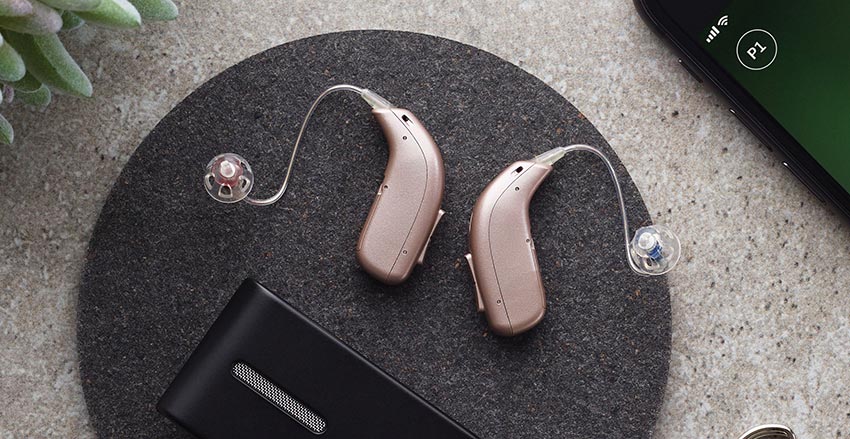
Behind-the-ear hearing aids
What characterizes behind-the-ear hearing aids?
- The main body of the hearing aids are placed behind the ear
- Has a clear tube or wire connecting it to an earmold or dome placed inside the ear canal
- Most people find behind-the-ear styles to be more comfortable than in-the-ear styles
- Examples of behind-the-ear instruments are BTE and miniRITE
In-the-ear hearing aids
What characterizes in-the-ear hearing aids?
- It is custom-made to fit the shape of your ear canal
- Is made of a hard material that sits inside the ear canal
- The size and shape of your ear canal determines if it is possible for you to have in-the-ear hearing aids
Conclusion:
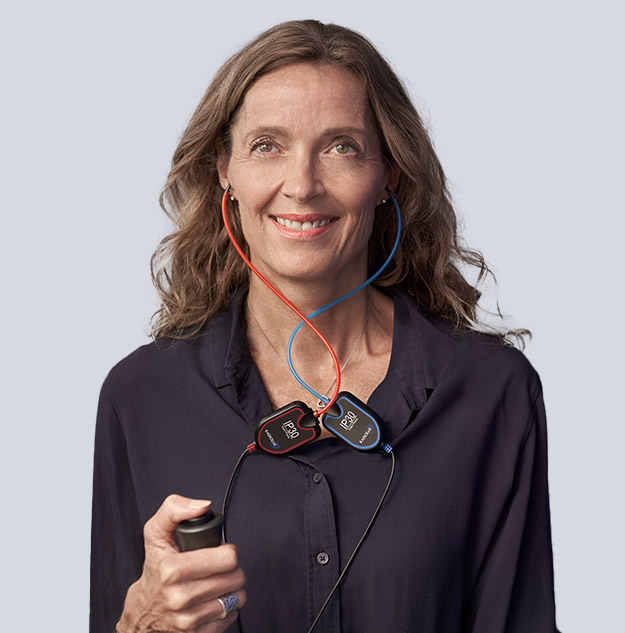
Our hearing care experts can increase your comfort
Comfort is one of the most important factors to consider when selecting hearing aids. Wearing hearing aids should never be uncomfortable.
Our hearing care experts are trained to help you find the most comfortable hearing aids for you. We will work with you to find the best hearing aids for your needs and lifestyle.
Factor 4 - Price and quality
The styles represented in Step 1 are available in multiple price ranges – in order to meet all budget needs.
The price of your hearing aid can depend on the number of features that you are looking for, such as automatic volume adjustment and wireless connectivity. Depending on your needs, these additional features can have a noticeable impact on the overall experience. Read further to learn more about the benefits provided by hearing aids today.
Behind-the-ear hearing aids have higher tech capabilities
Due to their larger size, behind-the-ear hearing aids provide the broadest selection of potential technological upgrades. However, the larger in-the-ear styles such as half-shell-in-the-ear and full-shell-in-the-ear styles do have the capacity for larger batteries and high technological capabilities as well.
Features available in hearing aids on the market today:
- Wireless connectivity to smart devices
- 360-degree sound (allowing a more “natural” hearing experience)
- BrainHearing™ technology by Oticon (allows your brain to do less work to process sound)
- Automatic adjustment for different sound settings
- Rechargeable battery option
- Telecoil option provides sound access in theatres and churches
Features available in hearing aids on the market today
You can enjoy a high-quality sound experience, as the newest hearing aids deliver more sound to the brain, increase speech understanding, and provide a clearer sound scene.
Conclusion:
Would you like more details about hearing aid prices?
You are welcome to visit one of our centers, and we can show you the available hearing aids and what they cost.
View a hearing aid price comparison table
Factor 5 - Style

Some appearance factors to consider are:
Size
Is long battery life or discreetness most important to you? Larger hearing aids (behind-the-ear or full-shell in-the-ear hearing aids) could be the best hearing aids for you if you are looking for larger batteries with high-tech capabilities and a longer battery life. Smaller, in-the-ear hearing aids could be the solution for someone with mild to moderate hearing loss who is most interested in discreet, nearly invisible hearing aids.
Color
Did you know that hearing aids are available in different colors? You have the option of finding hearing aids that blend with the color of your hair or skin tone – or just choosing a color that appeals to you.
Ear canal shape determines hearing aid size
The shape of your ear canal can also have an influence on the best hearing aid for you; since in-the-ear hearing aids are placed in the ear canal, a mold of your ear canal is taken, and the hearing aids are personalized to your unique ear canal shape.
As represented in Step 1, the invisible-in-the-canal and in-the-canal hearing aids are the smallest and least visible, and are suitable for most ear canals. If you’re interested in an in-the-ear hearing aid style, your hearing care professional will make a mold of your ear canal and determine which hearing aid style makes the most sense for you.
Would you like to see what styles of hearing aids are available?
You are welcome to book an appointment or visit one of our centers to see the different hearing aids that are available.Book appointment
Factor 6 - Lifestyle
Whether you enjoy spending time at home or out of the house at restaurants or social events, the best hearing aid for you will be one that matches your level of social engagement. The more active you are socially, the more “advanced features” you may want to look out for, and the less socially engaged you are, the more basic your hearing aids may be.
When considering which type of hearing aid will best fit into your lifestyle, your hearing care expert will most likely ask you about the activities you enjoy in your everyday life. It can be beneficial to explain to your hearing care expert which situations you look forward to hearing better in so that they can help you find the best hearing aid solution for your needs.
Hearing aids can improve your quality of life, and because everyone’s hobbies and social preferences are unique, it is a good idea to have this lifestyle discussion with your hearing care expert so that you can find the hearing aid that will help you get the most out of your everyday life.
Learn more about the different types of hearing aids
Read an in-depth overview of the different types of hearing aids.
Step 3. Purchase your hearing aids risk-free for 30 days at a hearing center
The knowledge that you have obtained in this guide can help you understand the most important factors to consider when choosing a hearing aid.
The next steps in the process are the following:
- Book a hearing assessment at one of our hearing centers
- Discuss your preferences and any questions you might have with your hearing care expert
- Purchase a hearing aid risk-free for 30 days
- Take the hearing aids home and wear them as a part of your everyday routine to determine if they are the right hearing aids for you
Make an appointment with a certified hearing care expert, who can help you understand how you get the:
- Best sound quality
- Best value for your money
Sources
- Santurette, S., Ng, E. H. N., Juul Jensen, J., & Man K. L., B. (2020). Oticon More clinical evidence.
- EEG testing with MoreSound Intelligence in on vs off setting, from Santurette et al.
- https://www.oticon.com/solutions/more-hearing-aids
- MarkeTrak 10, Marketing Research, Inc.

